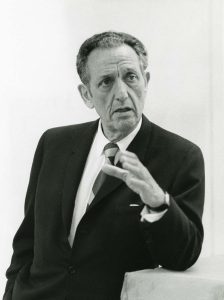Norton Simon Biography
One of the most profound means of human communication is the visual arts. By establishing a meaningful dialogue between an artist’s vision of the world and our own perceptions, art can help us to understand ourselves more fully. Moreover, art at its finest gives us a deep sense of history, tradition, and the true potentialities of man’s creativity. In today’s world where often scientific development is regarded as the highest goal and where the individual frequently feels alienated from himself and those around him, the role of art becomes increasingly important in keeping open the lines of communication.
– Norton Simon, 1972

Norton Simon believed deeply in the power of art to communicate. One of the outstanding American art collectors of the 20th century, he kept as a guiding principle his regard for the ability of the visual arts to inspire and reflect the human condition.
Norton Winfred Simon was born on February 5, 1907, in Portland, Oregon. He graduated from high school in San Francisco at age 16. Early on, Simon showed a strong proclivity for business and, in 1925, he moved to Los Angeles, where he established a sheet metal distribution company. He was a passionate businessman, with enthusiasm and a talent for negotiation. In 1929, at the start of the Great Depression, Norton Simon invested $7,000 in a foundering juice bottling company. He eventually turned his investment into the highly prosperous Hunt Foods, Inc. Through strategy, mergers and acquisitions, he built Norton Simon Inc., a multi-industry, multinational corporation that included Hunt-Wesson Foods, McCall’s Publishing, Saturday Review of Literature, Canada Dry Corporation, Max Factor cosmetics and Avis Car Rental.
Norton Simon’s accomplishments as an art collector equaled his extraordinary achievements in business. Over a period of less than 30 years, he amassed what is widely regarded as one of the world’s greatest private art collections.
Norton Simon’s interest in collecting art began in the 1950s with the works of Degas, Renoir, Gauguin and Cézanne. In the 1960s he shaped a major art collection of Old Master, Impressionist and Modern works, and this expanded in the 1970s to include Indian and Southeast Asian art.
During this time, Simon became an influential force within the Southern California art community. As a trustee of the Los Angeles County Museum of History, Science and Art, he encouraged the separation of the art and science activities, and he was a catalyst in the formation of the Los Angeles County Museum of Art.
By the mid-1960s, Simon’s two foundations—The Norton Simon Foundation (NSF) and the Norton Simon Art Foundation (NSAF)—were actively acquiring and displaying his art collections. He developed his own “museum without walls” concept, lending his art collections to museums throughout the world. He retired from corporate life in 1969 to pursue his interests in politics, art, higher education and medical research.
Involved in educational, cultural and philanthropic activities, Norton Simon served on the University of California Board of Regents, the Carnegie Commission on the Future of Higher Education, the boards of Reed College, the Los Angeles Music Center, the California School of Professional Psychology and the Institute for Advanced Study. In 1970, he briefly entered the political arena during the California Republican primary with an unsuccessful bid for the U.S. Senate. The same year, his marriage to Lucille Ellis Simon ended in divorce.
Norton Simon’s second marriage to actress Jennifer Jones in 1971 marked a turning point in the shaping of his collections. That summer, during the couple’s honeymoon trip to India, Simon began to explore Indian art. This led to his first purchase of Indian art, a Mughal ivory chess set and, more importantly, to an admiration for South and Southeast Asian art, which occupied a large part of his collecting interest for the remainder of his life.
By early 1974, Mr. Simon had begun to seek a permanent home for his large collection. He welcomed an overture from the financially strapped Pasadena Art Museum, and ultimately assumed its leadership, renaming it the Norton Simon Museum in October 1975. As loan commitments to other museums ended, his art collection traveled to Pasadena, where his vast “museum without walls” began to assemble within walls for the first time.
In 1984, Simon was stricken with the neurological disorder Guillain-Barré Syndrome, but he continued to oversee the Norton Simon Museum until his death in 1993.
I am not essentially a religious person, but my feeling about a museum is that it can serve as a substitute for a house of worship. It is a place to respect man’s creativity and to sense a continuity with the past. It is a place to give us a feeling of the dignity of man and to help us to strive towards our own creativity and fulfillment.
—Norton Simon, 1974